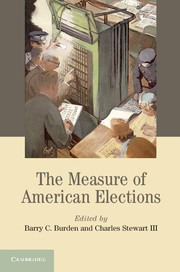Book contents
- Frontmatter
- Contents
- List of figures
- List of tables
- List of contributors
- Acknowledgments
- 1 Introduction to the Measure of American Elections
- 2 Registration and Voting: A View from the Top
- 3 Voter Registration: The Process and Quality of Lists
- 4 Provisional Ballots
- 5 Mail Ballots in the United States: Policy Choice and Administrative Challenges
- 6 Voting from Abroad: Evaluating UOCAVA Voting
- 7 Polling Place Practices and the Voting Experience
- 8 Disability and Election Policies and Practices
- 9 The Performance of Election Machines and the Decline of Residual Votes in the United States
- 10 Voter Confidence as a Metric of Election Performance
- 11 Election Data Transparency
- Appendix
- References
- Index
6 - Voting from Abroad: Evaluating UOCAVA Voting
Published online by Cambridge University Press: 05 August 2014
- Frontmatter
- Contents
- List of figures
- List of tables
- List of contributors
- Acknowledgments
- 1 Introduction to the Measure of American Elections
- 2 Registration and Voting: A View from the Top
- 3 Voter Registration: The Process and Quality of Lists
- 4 Provisional Ballots
- 5 Mail Ballots in the United States: Policy Choice and Administrative Challenges
- 6 Voting from Abroad: Evaluating UOCAVA Voting
- 7 Polling Place Practices and the Voting Experience
- 8 Disability and Election Policies and Practices
- 9 The Performance of Election Machines and the Decline of Residual Votes in the United States
- 10 Voter Confidence as a Metric of Election Performance
- 11 Election Data Transparency
- Appendix
- References
- Index
Summary
Federal elections in America are often very close. The National Commission on Federal Election Reform found that close elections are exceedingly common, whether they be U.S. House or Senate races or the state-by-state component of the presidential elections. Specifically, they found “a 90 percent likelihood that at least one state will have a presidential election within the one-percent technical margin of error.” The probability is 71 percent for U.S. Senate elections and 99 percent for House elections. In these close races, a small number of votes can change the outcome of the election.
Since the Civil War, it has been recognized that one population of voters whose participation can change the outcome of an election is military personnel. Most of the convenience voting we have today – absentee and early voting – dates back to efforts to enfranchise military voters in the 1864 election.
Recent efforts to enfranchise military personnel and the overseas civilian population have resulted in the passage of several pieces of legislation, including the Uniformed and Overseas Citizens Absentee Voting Act (UOCAVA) of 1986 and the Military and Overseas Voting Empowerment (MOVE) Act of 2009. 2 Under UOCAVA, eligible voters can complete the federal postcard application (FPCA), which allows them to simultaneously register to vote and submit an absentee ballot, or, if voters have not received a ballot from a local election official (LEO), they can complete the federal write-in absentee ballot (FWAB). These bills were intended to streamline the process of voting for covered individuals and make it easier for them to vote in federal elections. However, even with the passage of such legislation, the voting process for these individuals still has many barriers.
- Type
- Chapter
- Information
- The Measure of American Elections , pp. 141 - 165Publisher: Cambridge University PressPrint publication year: 2014
- 5
- Cited by

